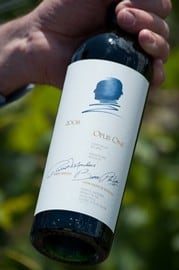Research firm Wine Intelligence wrote in its June 2012 China Label Report: “We found that mainstream consumers are more open to [high end] ‘Elegant Contemporary’ designs than we in the trade might have thought, as long as these styles convey the type of elegance and sophistication that is sought after in wine.”
Wine Intelligence research manager, Jenny Li, told BeverageDaily.com: "Historically, we thought that Chinese consumers bought brands looking very traditional, historic and 'Old World', but this research showed that Shanghai and Beijing consumers have already been exposed to innumerable brands.
"They are are no longer so naive as to be be constrained by traditional categories. They are looking for something different, and Elegant Contemporary fits in this respect - Californian wines are doing a good job in this respect, with Opus One [a 2008 vintage from the winery is pictured below] a very well received example."

Wine Intelligence interviewed 40 Chinese consumers between April and May 2012; all were resident in Beijing or Shanghai, aged 25-50 and earned less than RMB 4,000 (€500) per month.
Sixty to ninety minute interviews assessed factors such as wine drinking preferences, motivations and attitudes towards wine and a discussion of 40 sample label designs upon the basis of aesthetic preference, design, quality/price perception and suitable consumption occasions.
Bespoke label designs
Based on these findings, UK wine label agency Amphora designed eight bespoke design labels to best represent the key characteristics of each category, which Wine Intelligence then cross-checked against a further May 2012 online survey of Chinese upper middle-class imported wine drinkers.
Chinese consumers identified eight main label categories, according to Wine Intelligence, including (1) Prestigious (2) Stately (3) Modern Classic (4) Modern Contemporary (5) Modern Vibrant (6) Elegant Contemporary (7) Eclectic (8) Domestic.
Each category carried distinct quality, pricing and occasion associations. For instance, an ‘Elegant Contemporary’ design suggested high quality with unique characteristics at a high price, suitable for special occasions, celebrations, gifting or collecting.
However, such a design might not be the top choice for more conservative consumers, who used more traditional label categories as a quality cue, Wine Intelligence said.
Conversely, ‘Modern Vibrant’ suggested New World mainstream brands of mid-range quality at a low-to-medium price point, suitable for informal occasions or a casual dinner party at home.
Wine Intelligence looked at what design aspects worked well in each category in more depth, highlighting the risks and rewards, some major wine brands ran.
For instance, in the Modern Classic category, Chilean brand Casillero de Diablo (Concha y Toro) was praised by a Beijing male (aged 30-40) for the devil’s head embossment on its bottle.
“Small details such as a devil’s head embossment provide an element of uniqueness, while maintaining overall quality cues of the category,” Wine Intelligence said, given a mid-level price for such wines.
'Modern Classic' style runs risks
However, the firm warned that “some versions of this [Modern Classic] style can be seen as too mainstream and lacking in individual characteristics,” to aid stand-out appeal on the shelf.
For instance, one Shanghai male aged 40-50 said of a Jacob’s Creek (Pernod Ricard) wine: “It looks very mainstream, and I have seen it in the corner shops.”
In the ‘Eclectic’ category, South Africa brand Tall Horse won plaudits from a Beijing female aged 25-29 for its “nice colour scheme and cute design”, but label showing a giraffe and purple colour scheme were seen by a Shanghai male age peer as “like a child product, it looks too naïve”.
Wine labels for ‘Domestic’ wines involved Chinese characters on a traditional-looking label with some western test, a traditional old world wine look and a cream/white colour.
Such designs were mostly rejected amongst imported wine drinkers, Wine Intelligence said, and concerns lingered over quality (since Chinese wines copying Old World designs suggested counterfeits) and value, although such brands appealed on business occasions.
“I might order such wine when dining with people who are very local and don’t know anything about imported wine,” a Beijing male in the 40-49 age group told researchers.
